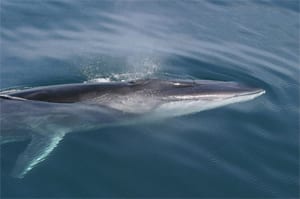Fin Whale

Fact Sheet
Common name: Fin Whale
Scientific Name: Balaenoptera physalus
Length as an adult: Up to 75 ft (22 m) in the Northern Hemisphere; Up to 85 ft (26 m) in the Southern Hemisphere
Weight as an adult: 80,000-160,000 lbs. (40-80 tons)
Length and weight at birth: 14-20 feet ( 5.5 -6.5 m) 2 tons (1,814 kg
Time Spent Nursing: 6-8 months
Range: Fin whales are found in all oceans of the world.
Likelihood of being seen on a whale watch in Massachusetts coastal waters: Very
Preferred food: Krill, and schooling fish
Unusual characteristics: The fin whale has two distinct blowholes on the top of its head, with a prominent splash guard in front of them.
Appearance: The fin whale has a V-shaped head which is flat on the top, and has a slender, streamlined body. The back and sides of the fin whale are black or brownish-gray and the ventral surface is white.
General Information: Fin whales are or finback whales the second largest species of whale. They are the fastest of the rorqual whales (baleen whales with dozens of throat pleats that expand while feeding). They prefer temperate and polar waters over tropical waters.
Unusual Habits: The fin whale neither approaches boats nor avoids them. The whale also swims on its side when feeding.
Status: It is estimated that there are about 40,000 fin whales in the northern hemisphere, and about 15,000-20,000 in the southern hemisphere.
Threats: Pollution
References:
- Carwardine, Mark. Whales, Dolphins, and Porpoises. London: Dorling Kindersley, 1995. Print.
- "Fin Whale (Balaenoptera Physalus) – Office of Protected Resources – NOAA Fisheries." Fin Whale (Balaenoptera Physalus) – Office of Protected Resources – NOAA Fisheries. N.p., n.d. Web. 07 Mar. 2013.
- "Fin Whale." American Cetacean Society. N.p., n.d. Web. 07 Mar. 2013.
Prepared by: Quinton Campbell


